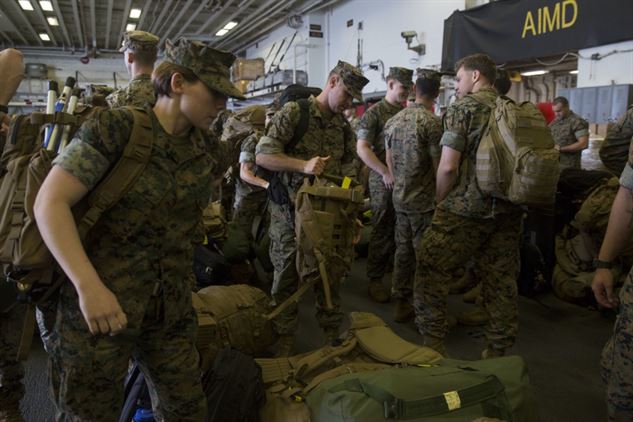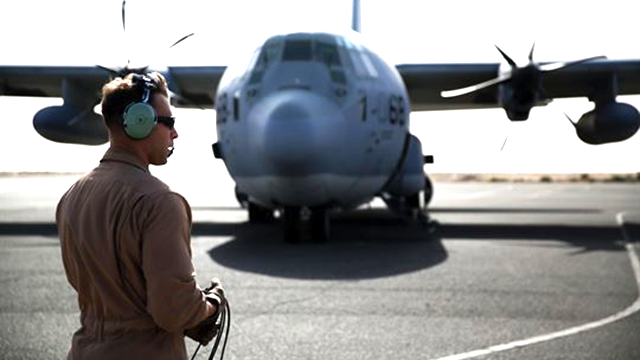Divisions
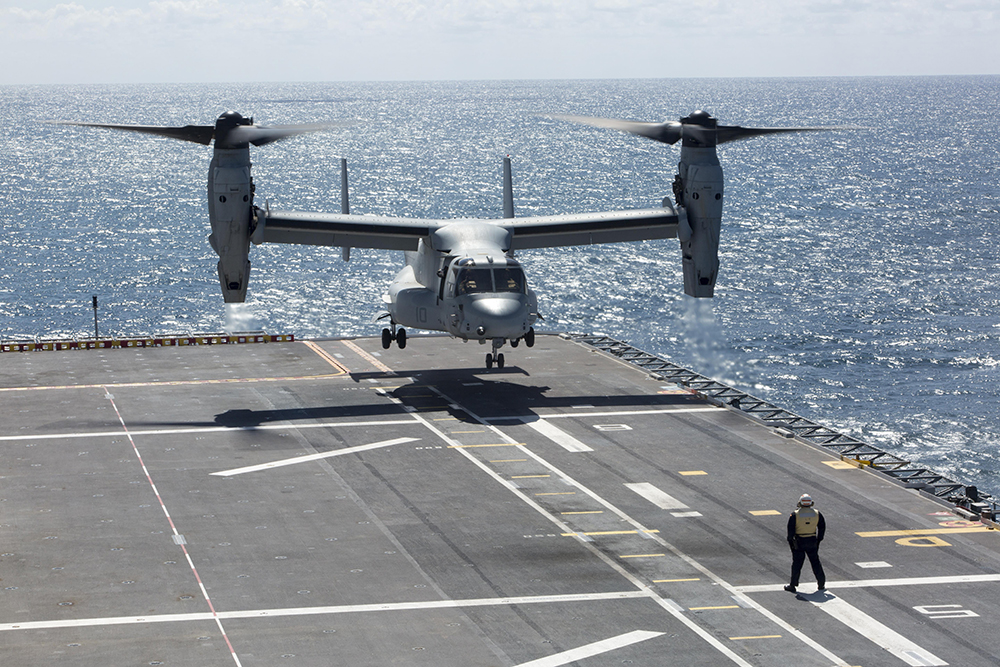
An MV-22 Osprey prepares to land on the deck of the Spanish amphibious assault ship, Juan Carlos I http://www.marines.mil/Photos/igphoto/2001641851/
As part of its Returning Commander Speaker Series, the Center for Adaptation and Innovation (CAI) hosted Colonel Daniel Q. Greenwood, USMC, Commander of the Special Purpose Marine Air-Ground Task Force Crisis Response Africa (SPMAGTF-CR-AF), Rotation 17.1, on June 8th 2017. The SPMAGTF-CR-AF was deployed from 1 October 2016 to 17 April 2017, to high-risk/high-threat posts in North and East Africa.
During its seven-month deployment, the SPMAGTF-CR-AF maintained “a laser focus on readiness and alert posture,” as part of their mission to provide crisis response capabilities for the USAFRICOM Area of Responsibility. First, they conducted “new normal” operations including bolstering embassy security, facilitating humanitarian assistance, preparing non-combatant evacuation operations, and integrating with Joint, Interagency, Intergovernmental, and Multinational (JIIM) organizations. Second, they participated in thirteen Theater Security Cooperation (TSC) events in nine different countries, as well as 24 multilateral training exercises, and 54 unilateral training events. Support to Special Operations Forces was also provided throughout the entirety of their deployment, and the SPMAGTF-CR-AF conducted tactical recovery of aircraft personnel, and enabling operations.
During the second half of their deployment, the SPMAGTF-CR-AF became the first to have its squadron reduced to 6 MV22s and 3 CV130s, in order to help improve aviation readiness throughout the Marine Corps. Colonel Greenwood explained that this “institutional decision to buy back aviation readiness in the long-term increased capability but decreased capacity.” This change had the unexpected benefit of doubling pilot proficiency hours, while maintaining a similar level of ready aircraft. However, this approach also required a “single site, single focus,” meaning they could no longer be divided across Africa.
Another focus of this deployment was the Allied Maritime Basing Initiative (AMBI), which aimed to develop amphibious capability, and foster interoperability with coalition partners. The SPMAGTF-CR-AF trained with the Spanish and French Navies, particularly with the Spanish amphibious assault ship, Juan Carlos I, due to its optimal location in southern Spain.
Throughout their deployment, SPMAGTF-CR-AF prioritized increased cooperation with the U.S. Department of State. Colonel Greenwood visited eight high-risk/high-threat posts in Africa, and collaborated with State Department officials in order to develop emergency response plans. These types of protocols became particularly relevant following an electoral crisis in The Gambia. They deployed a small forward element to Dakar, Senegal, to monitor and prepare for any necessary response.
Colonel Greenwood concluded, that the key takeaways from this deployment were the surprising benefit of the reduction to 0.5 VMM, increased aviation readiness, and the importance of integrating readily available technologies.
U.S. Marines disembark the USS Bonhomme Richard (LHD 6) after returning from their Spring Patrol of the Asia-Pacific region, April 6, 2017 http://www.31stmeu.marines.mil/News/News-Article-View/Article/1150416/31st-meu-phibron-11-complete-spring-patrol/
On May 4, 2017, the Center for Adaptation and Innovation (CAI) hosted the Bonhomme Richard Amphibious Ready Group (BHRARG) and 31st Marine Expeditionary Unit (MEU) as part of its Returning Commander Speaker Series. The 31st MEU is composed of approximately 2,300 Marines and Sailors from the command element (CE) and three major subordinate elements (MSE) – ground combat element (GCE), logistics combat element (LCE), and aviation combat element (ACE). The BHRARG is comprised of the amphibious assault ship USS Bonhomme Richard (LHD 6), the amphibious dock landing ship USS Green Bay (LPD 20), and the amphibious dock landing ship USS Ashland (LSD 48). The 31st MEU is the only continuously deployed MEU, and is deployed fifty percent of the time.
The BHRARG and 31st MEU were deployed to the Indo-Asia-Pacific Region for 163 days, and conducted training events and multinational exercise participation. The ARG/MEU completed two successful MEU certification exercises, four Theater Security Cooperation (TSC) port visits, a naval infantry exchange, and continued to focus on naval integration. For example, the ARG/MEU conducted Exercise Valiant Shield, an exercise off the coast of Guam to practice port and airfield seizures, as well as live fire support. Amphibious Landing Exercise 16 was also conducted. The purpose of this exercise was to improve the interoperability and capacity of the US Marine Corps, US Navy, Philippine Marine Corps, and Philippine Navy team. In addition, the 31st MEU conducted a subject matter expert exchange with the Vietnamese 147th Brigade Naval Infantry. The Vietnamese Navy provided the 31st MEU with an overview of Vietnam’s military history, as well as a tour of the Vietnam Military Museum and Ho Chi Minh bunker. The 31st MEU in return provided small unit recruiting training, unit level training, and knowledge of USMC weaponry. This exchange demonstrated improved relations with our Vietnamese counterparts, and an improved understanding of the capabilities of our regional partners.
According to Colonel Tye Wallace, Commanding Officer of the 31st MEU, the key takeaways from this deployment were a continued focus on amphibious warfare, coordination between naval partners, which increases effectiveness, and smoother transition periods since MEU personnel are never stabilized. He also stated, that we must look for ways to help the Marine Air Ground Task Force (MAGTF) “start the fight early.” Land, air, and sea must be looked at as one coherent battle space, and we must develop a “single maritime Common Operational Picture (COP)” to ensure naval readiness.
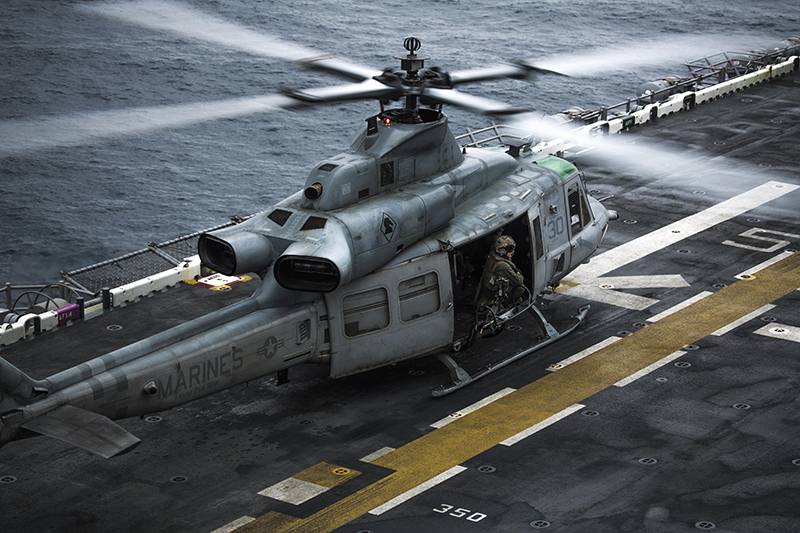
(Photo by Cpl. Ryan Coleman) U.S. Marines and Sailors with the Marine Medium Tiltrotor squadron 264 (REIN), 22nd Marine Expeditionary Unit (MEU) perform flight operations aboard the USS Wasp (LHD-1).
On 2 March 2017, the Center for Adaptation and Innovation (CAI) hosted the WASP Amphibious Ready Group (ARG) and the 22nd Marine Expeditionary Unit (MEU), as part of its Returning Commander Speaker Series. A MEU is uniquely equipped to be able to handle any crisis that arises while forward deployed. The MEU consists of four key elements, a command element, a ground combat element, an aviation combat element, and a logistics combat element. In total a MEU is comprised of roughly 2,200 Marines and Sailors.
Captain F. Byron Ogden (USN) and Colonel Todd P. Simmons (USMC) led the presentation of the WASP ARG and the 22 MEU. The combined units deployed from 25 June 2016 through 24 December 2016 to the European Command (EUCOM), Africa Command (AFRICOM), and Central Command’s (CENTCOM) Areas-of-Responsibility (AOR). The ARG/MEU provided a forward presence as the Global Response Force, AFRICOM Rapid Response Force, and CENTCOM Theater Reserve. The ARG/MEU also conducted Theater Security Cooperation exercises with 5 different partner nation militaries throughout their deployment.
While deployed, the ARG/MEU took part in Operation ODYSSEY LIGHTNING (OLL). OLL was an effort to counter Daesh in support of host nation forces in Libya. Marine V-22’s were critical in the logistical effort to ensure that all aircraft had proper munitions for the operation. The ARG/ MEU team was able to establish reusable tactics to gather intelligence from the air despite not having direct contact with militia fighters on the ground. Ultimately, the ARG/MEU proved successful in OLL. Their logistical tactics, unique communications strategies, and air power allowed Libya to take back Sirte, a major ISIS stronghold in Libya.
A U.S. Marine aircraft crewman with Marine Aerial Refueler Transport Squadron 352, Special Purpose Marine Air Ground Task Force – Crisis Response – Central Command, performs pre-flight checks in support of Operation Inherent Resolve
On March 16, 2017, the Center for Adaptation and Innovation (CAI) hosted the Special Purpose Marine Air Ground Task Force – Crisis Response – Central Command (SPMAGTF-CR-CC) as part of its Returning Commander Speaker Series. The SPMAGTF-CR-CC 16.2 recently returned from a 9-month deployment to Southwest Asia, where they conducted approximately 130 operations as part of their enduring mission to provide crisis response to regions of instability. The SPMAGTF-CR-CC is a rotational contingent of 2,300 Marines and Sailors, that conducts theater security, crisis response, and sustainment operations in support of the Central Command Area of Operations.
During their deployment, the SPMAGTF-CR-CC provided support to Operation Inherent Resolve, and conducted regional crisis response, theatre security cooperation operations, and sustainment and advancing the force training. As part of their support to Operation Inherent Resolve, the operation that works with regional partners to eliminate the Islamic State of Iraq and Syria (ISIS), the SPMAGTF conducted offensive air support, and provided support to Task Force Spartan, Task Force Al Asad, and Al Taqaddum. Additionally, the SPMAGTF sent a force to Qayarrah West for 180 days, to advise and assist the Iraqi Army division and police in the clearance of Mosul.
While conducting theater security cooperation, the SPMAGTF-CR-CC led multiple exercises in Jordan, Kuwait, Lebanon, Bahrain, and Egypt as part of their security engagement plan. Additionally, the SPMAGTF supported exercise “Eager Lion,” the largest military exercise the the Central Command area of responsibility. This exercise is a bilateral training exercise, to integrate the Jordanian and U.S. military forces. According to Colonel Kenneth Kassner, the SPMAGTF-CR-CC commanding officer, “all training served to enhance combat and contingency operations, and advance individual and collective skill sets.”
A highlight of this deployment was the level of Navy-Marine Corps integration employed.
Joint Tactical Recovery of Aircraft & Personnel (TRAP) exercises between the 2nd Battalion, 7th Marine Regiment and the SPMAGTF-CR-CC were conducted, as was an aviation operation in support of Maritime Surface Warfare. The Marines ashore with the SPMAGTF also maintained close ties with their Navy and Marine Corps counterparts afloat throughout their deployment.
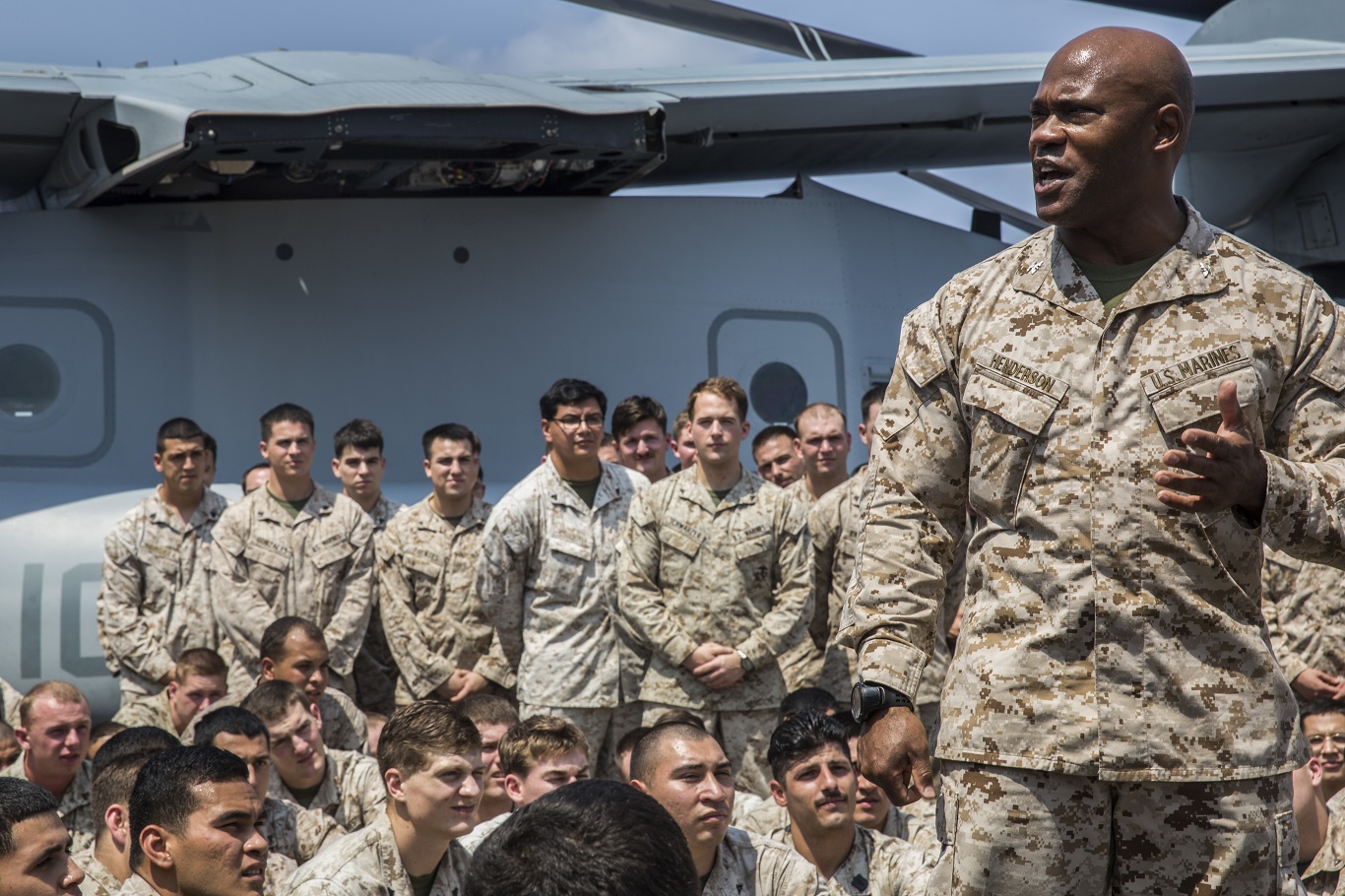
Col. Anthony M. Henderson, Commanding Officer of the 13th Marine Expeditionary Unit, addresses the Marines and Sailors aboard the USS New Orleans on April 4, 2016. https://news.usni.org/2016/09/12/13th-meu-co-argmeus-key-theater-mobile-forces
The Center for Adaptation and Innovation at the Potomac Institute for Policy Studies, as a part of its Returning Commander Series, hosted the 13th Marine Expeditionary Unit (MEU) on Thursday, 20 October. Retired Lieutenant General George Flynn introduced Colonel Anthony M. Henderson, commander of the 13th MEU, who presented on the Boxer ARG and 13th MEU’s most recent deployment. The Boxer ARG and 13th MEU deployed on 12 February for 213 days, and returned to California on 12 September 2016. The MEU provides a forward deployed, flexible, sea – based Marine Air Ground Task Force (MAGTF) capable of conducting amphibious operations, crisis response and limited contingency operations. They consist of a command element, a reinforced infantry battalion, a composite aviation squadron, and a combat logistics battalion. The MEU is comprised of about 2,100 Marines and Sailors.
The Boxer ARG and 13th MEU conducted multiple sustainment training and operational exercises and supported Freedom of Navigation operations in the Pacific Command – (PACOM)and Operation Inherent Resolve (OIR) in, Central Command –(CENTCOM). OIR operations included strike operations by AV-8B Harriers against ISIL targets.
In addition to sustaining ground readiness, aviation readiness was also maintained. Over 6000 flight hours were conducted, which maximized aviation efficiency. As stated by Colonel Henderson, “We have to keep the flight hours going as much as possible, that saves lives.” Aircraft were launched simultaneously from two separate regions, which enabled integration between two separate MAGTFs. Unique to this deployment, command and control was maintained across three separate seas.
During its deployment cycle, the 13th MEU also executed several amphibious and expeditionary exercises and operations to include:
− Theater Security Cooperation exercises and amphibious training in Sri Lanka, Singapore, Indonesia, and Malaysia
− Support to POTUS visit
− A combined amphibious joint forcible entry exercise in Exercise SSANG YONG 16
− Sustainment training
− Security force missions and Joint Theater Cooperation exercises to safeguard US personnel and equipment in support of IMCMEX and Exercise EAGER LION 2016 in Jordan

